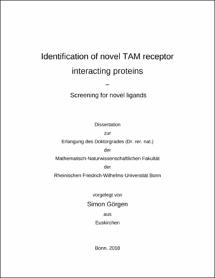Identification of novel TAM receptor interacting proteinsScreening for novel ligands

Identification of novel TAM receptor interacting proteins
Screening for novel ligands

| dc.contributor.advisor | Latz, Eicke | |
| dc.contributor.author | Görgen, Simon | |
| dc.date.accessioned | 2020-04-26T10:04:02Z | |
| dc.date.available | 2020-04-26T10:04:02Z | |
| dc.date.issued | 07.02.2019 | |
| dc.identifier.uri | https://hdl.handle.net/20.500.11811/7861 | |
| dc.description.abstract | The TAM receptors TYRO3, AXL, and MER are well characterized for their roles in cell proliferation and survival, phagocytosis, and inhibition of inflammation. The complexities of these TAM receptor responses imply a level of orchestration beyond binding to the two well-characterized ligands GAS6 and Protein S. The here presented study was initiated to identify novel TAM receptor interacting proteins to gain novel insight into TAM receptor functions. Previously published studies aimed to identify ligands were insufficiently sensitive to capture weak and transient interactions, yet identified TUBBY, TULP1, and Galectin 3 as TAM activators by screening retinal cDNA libraries. The screen performed for this study was tailored to capture weak and transiently interacting proteins in a wide range of tissues. The attachment of tri-functional Diazirine cross-linker molecules to the n-termini of bait proteins was established via the bacterial transpeptidase Sortase A, as the enzymatic method provides site specificity and product homogeneity superior to chemical linking techniques. The cross-linker tagged bait proteins produced for this study enabled a variety of methods to enrich captured proteins. In total, three methods were compared for their capacity to enrich novel TAM ligand candidates. Applying the optimal enrichment method, several human and mouse tissues were screened for novel TAM receptor interacting proteins. Enriched proteins were identified by mass spectrometry and evaluated by bioinformatic and biochemical methods. A sum of 83 proteins was found to be potential TAM receptor ligands, which were not previously associated with TAM receptors. Beside proteins indicated to interact individually, clusters of proteins were enriched. AHSG (Fetuin A) links TAM receptors to mineralo-organic complexes and calcification of soft tissues such as atherosclerotic plaques, where AHSG inhibits calcification and acts cytoprotective. 19 proteins are characterized as vesicle markers. Recent publications link the release of vesicles by activated immune cells to immunosuppressive TAM receptor signals in cells recognizing these vesicles. In addition, 12 ribosomal proteins were enriched that may be recognized by TAM receptors as an alternative 'eat me' signal for phagocytosis, as ribosomal proteins translocate to the outer membrane in apoptotic bodies. The identification of additional 'eat-me' signals and the identified interaction of TAM receptors with vesicles emphasize the question of how TAM receptors differentially recognize vesicles and cells that either do, or do not present Phosphatidylserine. The 83 novel TAM receptor enriched proteins therefore may serve as starting points for the better understanding of TAM receptor mediated regulation of our immune system, maintenance of tissue homeostasis by clearing apoptotic cells and debris, and supporting healthy or causing malignant cell survival and proliferation. | en |
| dc.language.iso | eng | |
| dc.rights | In Copyright | |
| dc.rights.uri | http://rightsstatements.org/vocab/InC/1.0/ | |
| dc.subject | TAM Receptor | |
| dc.subject | TYRO3 | |
| dc.subject | AXL | |
| dc.subject | MERTK | |
| dc.subject | GAS6 | |
| dc.subject | Protein S | |
| dc.subject | PROS1 | |
| dc.subject | sortase A | |
| dc.subject | srtA | |
| dc.subject | interactor screen | |
| dc.subject | AHSG | |
| dc.subject | ENO1 | |
| dc.subject | RAN | |
| dc.subject | ribosomal proteins | |
| dc.subject | vesicles | |
| dc.subject | immunoglobulins | |
| dc.subject.ddc | 500 Naturwissenschaften | |
| dc.subject.ddc | 610 Medizin, Gesundheit | |
| dc.title | Identification of novel TAM receptor interacting proteins | |
| dc.title.alternative | Screening for novel ligands | |
| dc.type | Dissertation oder Habilitation | |
| dc.publisher.name | Universitäts- und Landesbibliothek Bonn | |
| dc.publisher.location | Bonn | |
| dc.rights.accessRights | openAccess | |
| dc.identifier.urn | https://nbn-resolving.org/urn:nbn:de:hbz:5n-53445 | |
| ulbbn.pubtype | Erstveröffentlichung | |
| ulbbnediss.affiliation.name | Rheinische Friedrich-Wilhelms-Universität Bonn | |
| ulbbnediss.affiliation.location | Bonn | |
| ulbbnediss.thesis.level | Dissertation | |
| ulbbnediss.dissID | 5344 | |
| ulbbnediss.date.accepted | 17.01.2019 | |
| ulbbnediss.institute | Medizinische Fakultät / Institute : Institut für Angeborene Immunität | |
| ulbbnediss.fakultaet | Mathematisch-Naturwissenschaftliche Fakultät | |
| dc.contributor.coReferee | Schultze, Joachim L. |
Dateien zu dieser Ressource
Das Dokument erscheint in:
-
E-Dissertationen (4337)




